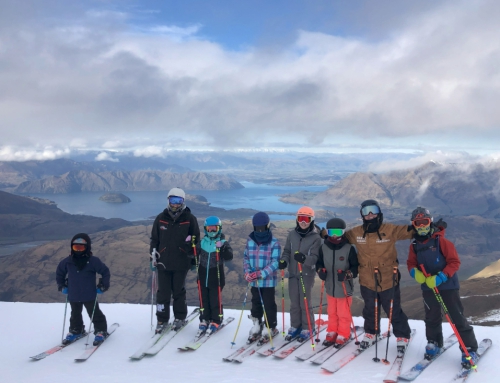Interski 2023: Snowboard Takeaways from Australia’s Workshop
Held every four years, Interski brings instructors together from around the world. The event offers a valuable educational opportunity for snowsports instructors to share their innovations and core beliefs. It gives PSIA-AASI, through its national team, an opportunity to compare the American Teaching System with educational approaches of other countries and bring home ideas that help PSIA-AASI members improve and evolve.
Here, PSIA-AASI Adaptive Team member Christina Bruno and AASI Snowboard Team members Matt Larson and Lyndsey Stevens share their top takeaways from Australia’s ‘Moving with Purpose’ workshop.
Christina Bruno: Australia’s riding conditions encourage instructors to focus on core movement patterns for snowboarding. They value a style of riding that is successful in frozen or firm conditions where it’s important to build a strong platform to change edges. They emphasize an extension movement to flatten the board and unweight it before setting a good edge. This up un-weighting extension movement is how they choose to initiate the board. They also use full body rotation for steering, which looks like the core moving together to anticipate the next turn.
The Australian team used drills to teach us how to ride using their system. We rode T-bar corridors for drills that are exactly one snow-cat width.
We use similar drills in adaptive to prepare instructors to seat assist. We use a ground toe-to-toe with a slip in the fall line to reset yourself and the bi-ski.
Matt Larson: To accommodate firm conditions, in Australia it is super important to stack yourself over your board. Within the certification process, they have assessment activities that assess for being stacked at edge change combined with variations of up and down unweighted movement patterns. At the highest level this is also combined with switch riding.
One of the activities for assessing the movement patterns was toe-to-toe, small, skidded turns which target the focus of being stacked over the board at edge change. A rider will not be able to accomplish the task with whole body rotation, so they need to rely on other performances of the snow such as twist if they are not stacked at edge change.
Lyndsey Stevens: I noticed that as I tried to mimic the Australian technique, I had to limit my range of motion in my spinal rotation movements. Because of this, I had to exaggerate my vertical pressure movements to steer the board with minimal rotation movements.
These drills were performed down the edge of a run. We slalomed around bamboo markers. The snow was variable because we were riding over the edge of a groomer line between the trail and off-piste. This approach can help instructors enhance technical skills for variable terrain.







